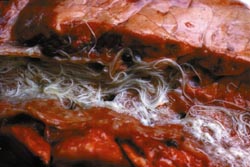
Cases of clinical husk (lungworm) in adult cows and calves were up last season and vaccination should be seriously considered by dairy and beef producers alike, warns vet Neil Howie of the Nantwich Vet Group in Cheshire.
"Summer 2003 was a classic lungworm year with nice warm conditions, followed by rain coupled with high temperatures," he says. "The extended grazing season also meant cattle were still out 25-30 weeks after having been wormed. After this amount of time, the protection from long acting bolus or pour-on wormers will be waning. This leaves cattle susceptible, particularly to lungworm infection as they will not have been able to develop any natural immunity."
The effects of a lungworm outbreak can be devastating, affecting milk yield and growth rates, as well as causing fatalities. Mr Howie cites the example of a local farmer who rented some different summer grazing for some dry cows and then, on bringing them into the herd, suffered a whole-herd outbreak. Because of the type of protection being gained from wormers, and the timing of the outbreak, the infection hit the herd very hard and three or four adult cows were lost.
"Increasingly, we are advising clients to develop a worming strategy that combines long acting wormers with Huskvac vaccination according to their grazing strategies and calving patterns," Mr Howie adds. "For example, in some cases it seems best to turn out relatively young heifers in the summer, worm them but don't vaccinate and then vaccinate them pre-turnout for their second grazing season. This means that a certain level of natural immunity can be developed, and the most effective protection is gained for their second season, when they are likely to be at significant risk."
Given the increase in cases of lungworm in adult cows, the recommendation to farmers is to vaccinate immediately prior to turnout, and also to consult their vet to establish the best strategy for their system.
A substantial number of Mr Howie's clients now regularly vaccinate with Huskvac. He maintains that one of the main factors in persuading farmers is to show how damaged lungs can be after an outbreak. "It is inconceivable that an animal – beef or dairy – can perform decently with the type of lung damage seen following lungworm infection. The message we give to our clients is that lungworm prevention is much better than its cure."
